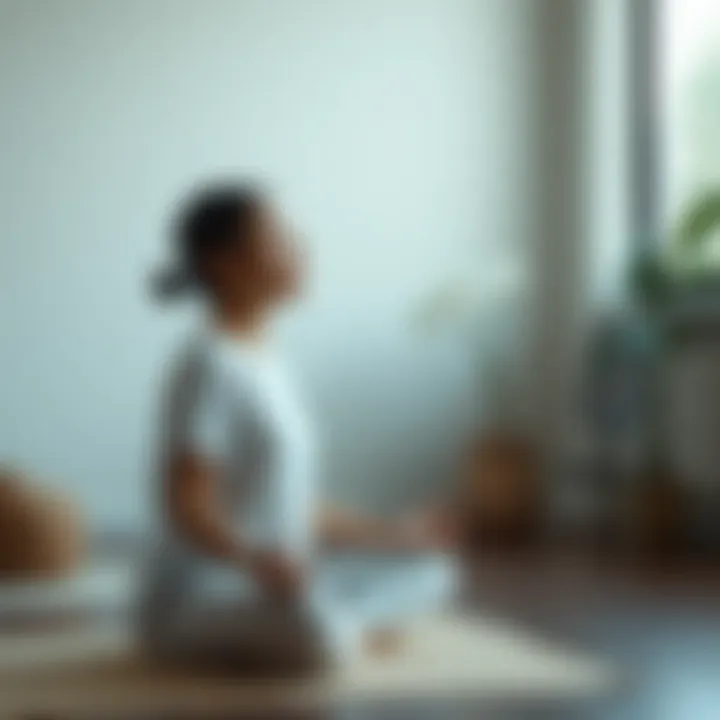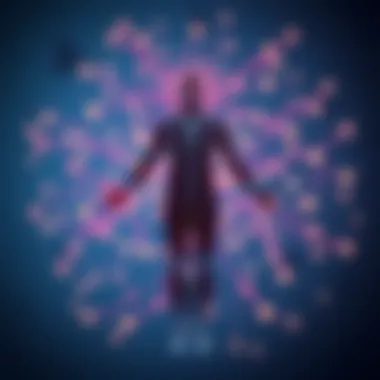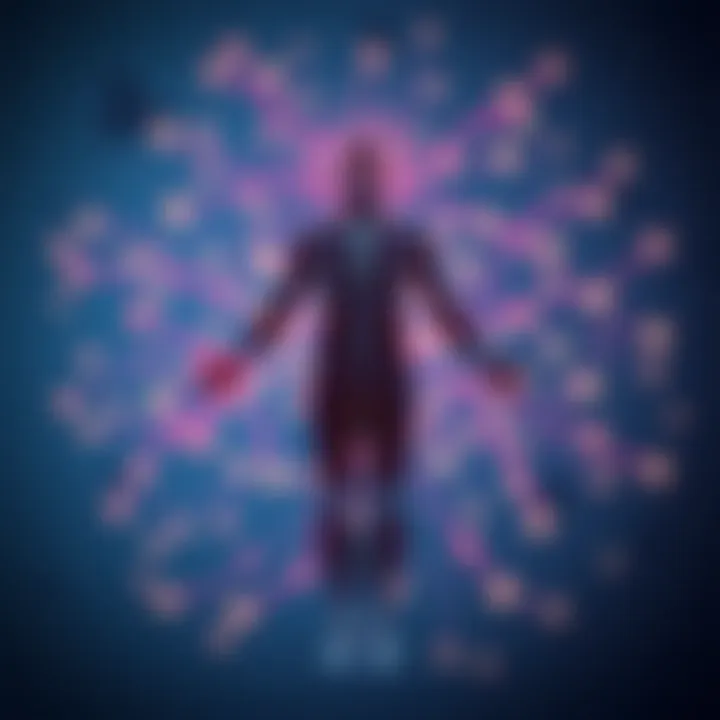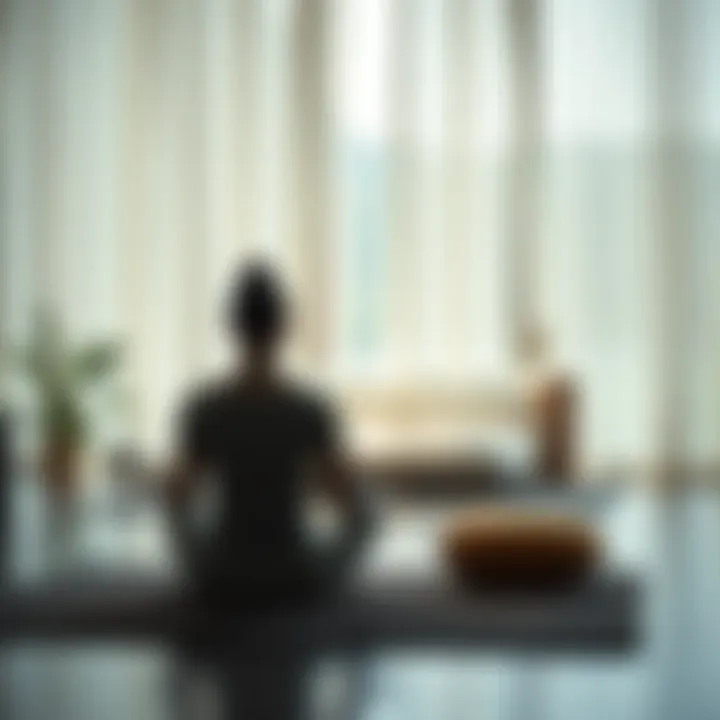Exploring Body Scan Meditation for Mindfulness


Intro
In an ever-accelerating world, where the buzz of daily life can feel like a heavy cloak enveloping us, the importance of mental health has burgeoned into a focal point for many. Understanding mental health is not merely about identifying challenges or disorders. It's about harnessing the tools and approaches that can lead to a more fulfilling life. One such powerful method is meditation, particularly body scan meditation, which reveals the connection between body awareness and mental well-being.
Body scan meditation encourages practitioners to delve deep into their own physical sensations, paving a pathway not just to mindfulness but to a fuller understanding of oneself. By engaging systematically with different areas of the body, individuals can cultivate a relationship with their physical self that furthers emotional awareness and psychological flexibility.
Let’s embark on this exploration by laying a foundation with an understanding of mental health and its nuances.
Foreword to Body Scan Meditation
The practice of body scan meditation holds a significant place in the realm of mindfulness. It’s not merely about sitting quietly; it's a journey into one’s own consciousness, revealing layers of awareness that often slip through the cracks of daily life. This technique aids in developing a strong connection with your body and your mind, effectively pushing aside the noise of distractions and worries that can cloud judgment and hinder peace. The significance of body scan meditation lies in its ability to foster a heightened sense of awareness, encouraging individuals to listen to their bodies in ways they perhaps have never considered before.
Defining Body Scan Meditation
Body scan meditation can be described as a method where you focus your attention on various parts of your body, often sequentially, promoting relaxation and mindfulness. Typically practiced while lying down or sitting comfortably, the participant directs their awareness from the tips of the toes to the crown of their head. This focus helps to highlight sensations, emotions, or areas of tension.
What sets body scan meditation apart from other mindfulness techniques is its systematic approach to awareness. Unlike other meditative practices that might emphasize breathing or visual imagery, body scan meditation calls for a fine-tuned attention to the physical self. It encourages the practitioner to observe sensations without judgment, cultivating a deeper understanding of how emotions and physical states are intertwined.
Historical Context and Origins
The roots of body scan meditation trace back to various traditions of mindfulness and meditation, particularly found in Buddhist practices. Historical accounts point towards its development within the mindfulness movement spearheaded by individuals like Jon Kabat-Zinn in the late 20th century. Kabat-Zinn integrated these techniques into his Mindfulness-Based Stress Reduction (MBSR) program, aimed at assisting patients dealing with chronic pain and stress.
As the practice spread, it began attracting attention beyond the confines of traditional meditation circles, drawing in those seeking psychological and emotional relief from the pressures of modern life. The growing body of scientific research on mindfulness has only solidified the practice's standing amidst health and wellness therapies.
Comparison with Other Mindfulness Practices
When held up alongside other mindfulness practices—such as breath-focused meditation or guided visualization—the body scan uniquely emphasizes the physical aspect of mindfulness. While breath meditation urges practitioners to focus solely on inhaling and exhaling, and guided visualizations engage the mind through imagery, body scanning draws attention to the tangible sensations within the body.
- Breath Meditation: Focuses on the rhythm of breathing, often leading to calming effects through breath awareness.
- Guided Visualization: Utilizes imaginative scenarios or landscapes to promote relaxation and reduce stress, relying heavily on mental imagery.
- Body Scan: Engages each part of the body in conscious awareness, allowing practitioners to tune into physical sensations and connections between mind and body.
By incorporating body scan meditation into one's routine, individuals can complement their practice of other mindfulness techniques, ultimately creating a more robust strategy for enhancing overall mental and emotional wellness.
The Mechanism of Body Scan Meditation
Understanding the mechanisms behind body scan meditation is crucial to appreciate its depth and efficacy. This method serves not only as a technique to promote relaxation but also as a powerful tool for fostering a connection between the mind and body. By diving into the nuances of this practice, readers can see how it lends itself to various benefits, which can be pivotal in their journey toward enhanced mental well-being and clarity.
Understanding the Mind-Body Connection
The mind-body connection is a cornerstone concept in many wellness practices, with body scan meditation being no exception. At its essence, this connection represents how our thoughts, emotions, and physical sensations interact dynamically.
When engaging in body scan meditation, practitioners focus their attention systematically on different body parts. This focus encourages an awareness of physical sensations, feelings, and even thoughts that may arise. Surprising as it may be, many people go through life largely unaware of how tension or discomfort in their body reflects emotional states. As one learns to recognize these signs, they can cultivate a healthier response to stressors, whether they be external pressures or internal anxieties. By fostering this awareness, individuals often notice shifts not just in their emotional health but also in their physical vitality.
Neuroscientific Insights into Body Awareness
Recent advancements in neuroscience provide fascinating insights into the workings of body awareness during meditation. Research shows that when people practice body scans, there are observable changes in brain activity. The insula and somatosensory cortex—areas dedicated to processing sensory information—become more activated. This heightened activity is significant because it suggests a greater integration of sensory input with emotional responses.
Studies indicate that body scan meditation can lead to a reduction in the size of the amygdala, a brain region heavily involved in processing emotions, particularly fear and stress.
Furthermore, regular practice can help to rewire the brain, promoting resilience against anxiety and improving the overall emotional response system. These neuroscientific foundations validate what many practitioners have experienced intuitively: paying attention to our bodies can transform our emotional landscape.
Physiological Changes During the Practice
The practice of body scan meditation also instigates notable physiological changes that contribute to heightened well-being. When one consciously directs attention to their body, it enhances the parasympathetic nervous system's activation, promoting relaxation.


Some specific physiological benefits include:
- Reduction in Heart Rate: Individuals frequently report a noticeable drop in heart rate, indicating a shift towards a calmer state of being.
- Decreased Muscle Tension: Through conscious awareness, many are able to identify areas of tension and consciously relax them, leading to a significant overall reduction in body stress levels.
- Improved Breathing Patterns: Individuals learn to take deeper, more measured breaths, which enhances oxygen flow, promoting a sense of rejuvenation and clarity.
Additionally, regular practice can enhance sleep quality and reduce feelings of fatigue. Thus, practicing body scan meditation catalyzes not just mental awareness, but profound physiological shifts that bolster resilience and overall wellness.
"Awareness is the first step to change. By understanding our body's signals and connecting with them through practices like body scan meditation, we empower ourselves to foster lasting mental health improvements."
Through this examination of the mechanisms at play in body scan meditation, it becomes evident that it is not merely a passive pastime; rather, it is an active engagement in the practice of mindfulness that has far-reaching benefits for the mind, body, and spirit.
Benefits of Body Scan Meditation
Body scan meditation has gained recognition as a powerful tool for individuals seeking to enhance their mental well-being and deepen their connection with themselves. In today’s fast-paced world, many people overlook the signals their bodies send, often leading to chronic stress and anxiety. The benefits of body scan meditation extend beyond relaxation; it cultivates a significant sense of presence and awareness that can be transformative.
Reducing Stress and Anxiety
One of the primary advantages of body scan meditation is its ability to significantly reduce stress and anxiety. When practiced regularly, it encourages participants to tune into their bodies, which counteracts the flighty thoughts that often arise in stressful situations. By focusing on the different bodily sensations—from the top of your head down to your toes—you can identify where thoughts and emotions manifest physically. This mindfulness practice allows for a release of pent-up tension.
"Mindfulness is a way of befriending ourselves and our experience."
— Jon Kabat-Zinn
Enhancing Emotional Regulation
Alongside stress reduction, body scan meditation supports emotional regulation. Individuals often grapple with intense emotions that can feel overwhelming. This practice provides a structured method to acknowledge and accept these feelings. Instead of pushing emotions away, participants learn to observe them without judgment. This detachment fosters a powerful approach to emotion management, allowing individuals to respond rather than react, leading to more measured behavioral outcomes in everyday interactions.
Improving Sleep Quality
Struggling to catch those elusive Zs can be a nightmare in itself. Body scan meditation features prominently in boosting sleep quality. Engaging in this practice before bedtime prepares the mind for rest. By shifting the focus from daily worries to awareness of physical sensations, stress levels lower, paving the way to a more peaceful night’s sleep. Instead of counting sheep, why not count your breaths? This quiet reflection stimulates feelings of calm, making it far easier to drift off.
Fostering Self-Compassion
In the hustle and bustle of life, many are prone to self-criticism and harsh judgments. Body scan meditation promotes self-compassion by encouraging gentle acknowledgment of discomfort or pain as natural human experiences. Instead of pushing these feelings away, practitioners are reminded to approach themselves with kindness. This self-awareness leads to a deeper understanding of one's limitations and strengths, weaving a thread of kindness throughout our self-talk.
Promoting Physical Relaxation
Lastly, the physical relaxation facilitated by body scan meditation is remarkable. As individuals systematically focus on each part of their body, they identify areas of tension and consciously invite relaxation into those spaces. It is a bit like tuning an instrument; when each part is aligned, the whole system enhances its performance. Regular practice can result in decreased muscle tension, smoother circulation, and an overall sense of vitality. It’s a gift of awareness that fosters a healthier relationship with the body.
In summary, the benefits of body scan meditation encompass significant mental, emotional, and physical health improvements. These benefits aren’t just a fluke; they represent a foundational practice that reawakens mindfulness in daily life, paving the way for lasting changes.
How to Practice Body Scan Meditation
Practicing body scan meditation is pivotal in unlocking the door to mindfulness and fostering a deep-seated connection with oneself. This technique invites individuals to tune into their bodies, fostering a sense of awareness often drowned out by the chaos of daily life. Understanding how to practice body scan meditation not only enhances mental well-being but also nurtures emotional balance, providing a refuge for personal growth and introspection. Here, we'll explore key steps to integrate this practice, making it accessible and effective for anyone looking to prioritize their mental health.
Setting the Right Environment
Creating the right atmosphere is significant for any meditation practice, and body scan meditation is no different. The environment you choose can either enhance your experience or distract your focus. Aim for a peaceful area – perhaps a quiet room or even a comfortable spot in a park if nature calls to you. Here are some elements to consider:
- Lighting: Soft, natural light is most conducive to relaxation, but dimmed artificial lights can also do the trick.
- Comfort: Use cushions or blankets to ensure your comfort level is high. Consider temperature too; a cozy space aids in relaxation.
- Minimal Distractions: Turn off devices or anything that makes noise. If you live with others, let them know you need some time to yourself.
- Fragrance: Scent can trigger calmness. Using essential oils or incense can help enhance the ambiance.
In short, a good space is vital for the practice to stick. Without it, you might end up thinking more about the noise outside than your own body.
Step-by-Step Guide to the Practice
The body scan meditation can seem intimidating at first, but breaking it down into steps makes it manageable. Here’s how to embark on this mindful journey:
- Lie Down Comfortably: Find a suitable position, lying flat on your back. Keep your arms resting gently by your sides or on your stomach.
- Close Your Eyes: Gently shut your eyes and take a moment to land into this space. Feel the surface beneath you, connecting you to the earth.
- Begin with the Breath: Inhale deeply through your nose and exhale slowly through your mouth. Do this a few times to settle into your body.
- Focus on Each Part: Start from your toes and move upward. Gradually direct your attention to each body part. Feel any sensations, tension, or relaxation.
- Acknowledge Without Judgment: Just notice what you feel. If there is discomfort, acknowledge it; if there is calm, embrace it.
- Return to the Breath: Once you’ve scanned your entire body, take a few more breaths. Let this awareness fill you, then gradually make your way back to the present moment.
- Open Your Eyes: When you are ready, gently open your eyes and take a moment before getting up.


Practicing regularly can help solidify the habit and deepen the experience. It’re like training a muscle; the more you do it, the stronger your mindfulness becomes.
Integrating Breath Awareness
Breath awareness is integral to body scan meditation, serving as both anchor and guide throughout the practice. Focusing on your breath provides a pathway to being present and centering your mind, especially when distractions pop up. Here’s how to weave breath awareness into your body scan:
- Begin with Breathing Techniques: As mentioned earlier, starting with focused breathing prepares the mind and body. It cultivates a sense of readiness for deeper awareness.
- Use Breath as a Guide: As you scan through different body parts, synchronize your breath with your focus. For example, as you breathe in, visualize filling any tension in that area with calmness. When you exhale, imagine releasing any discomfort.
- Anchor During Distraction: Whenever the mind starts to wander, gently return to your breath. This small act can ground you and remind you of your purpose without judgment.
- Build Deep Awareness: Gradually, inhaling and exhaling can be a way to deepen your experience. Pay attention to the rhythm, feeling the rise and fall of your chest and abdomen. This awareness can enrich the practice.
Integrating breath into the body scan meditation not only amplifies the experience but enhances one's ability to sustain focus and channel energy inward.
In summary, practicing body scan meditation lies at the intersection of awareness and mindfulness, making it essential for holistic mental health. Implementing it with a conducive environment, a clear step-by-step approach, and focused breath awareness can unlock deeper layers of self-connection."
Common Challenges and Solutions
Practicing body scan meditation can indeed be a rewarding journey toward mindfulness and self-awareness, but like many paths worth traveling, it comes with its share of bumps. It's essential to recognize common challenges that practitioners may encounter and to have practical solutions in place. This section will delve into some of those common obstacles, focusing on encountering restlessness, dealing with distractions, and sustaining consistency in practice.
Encountering Restlessness
Restlessness is like that pesky fly buzzing around your head when you’re trying to enjoy a quiet afternoon. It’s frustrating, and it can derail your meditation session pretty fast. Practitioners often think that once they sit down, calmness will wash over them like a soothing wave. However, it doesn’t always go as planned. The body may feel fidgety, and the mind can feel like it's running a mile a minute.
To tackle this, acknowledgment is key. Instead of pushing these feelings away, you might try to notice them without judgment. Picture yourself standing at the edge of a river, observing your thoughts and sensations float by. One effective technique is to gently refocus on your breathing. Just a few deep, intentional breaths can send the restless energy packing. If restlessness persists, consider easing into a brief stretch or changing your position. Listening to your body is crucial; sometimes it knows what you need better than you do.
Dealing with Distraction
Distraction can come from every corner—external noises, an itch you can’t ignore, or even that nagging to-do list weighing on your mind. It’s common, and it’s something that many practitioners grapple with. In a world buzzing with stimuli, focusing during body scan meditation may feel like trying to catch smoke with your bare hands.
Some practical approaches can help here. Start by creating an ideal environment—choose a quiet space and, if it helps, use soft lighting or calming scents to minimize distractions. If your mind wanders, gently remind yourself that it’s part of the process. Try using simple sound cues throughout the practice. This could be a gentle bell or a soft track that re-centers you when distractions arise. Lastly, try to engage your senses; think of each body part you’re scanning as a world unto itself. This can transform your practice into a rich exploration rather than a check-off-the-list task.
Sustaining Consistency in Practice
Staying consistent can feel like climbing a mountain without a clear path. Life often gets in the way; schedules and responsibilities can pull you in different directions. How can one stay committed to body scan meditation amidst the chaos?
Establishing a routine can do wonders. Set a specific time each day for your practice, making it as essential as your morning coffee. You might place reminders in visible places—sticky notes on the fridge or phone alerts can serve as effective nudges. Starting with short sessions can ease you into a consistent practice; even 5 to 10 minutes can be beneficial. As you grow more comfortable, gradually lengthen these sessions. Finding a meditation buddy can be a great motivator as well; when you know someone is counting on you, it can give you that extra push.
In summary, confronting challenges during body scan meditation is common, and knowledge of how to tackle these challenges can enhance your experience significantly. Whether it's acknowledging restlessness, creating a distraction-free environment, or building consistency into your routine, each step can lead to a richer engagement with meditation and its myriad benefits.
Enhancing the Body Scan Meditation Experience
Enhancing the body scan meditation experience transforms a standard practice into a profound journey of self-exploration. The importance of enriching this meditation cannot be overstated, as it helps practitioners engage more deeply, fostering a genuine connection between mind and body. When the experience is tailored to individual preferences, it can significantly amplify the benefits of mindfulness, creating a space where awareness is heightened and inner peace can flourish.
Incorporating Guided Sessions
Guided sessions can be incredibly beneficial for those new to body scan meditation or even seasoned practitioners looking to deepen their practice. By incorporating a voice that leads the meditative process, individuals gain a sense of direction that can ease them into relaxation and encourage focus. Guides can offer soothing instructions, helping participants navigate each step with clarity, enabling a deeper connection with their sensations.
Many meditation apps like Headspace or Insight Timer provide excellent guided sessions tailored to various needs. Furthermore, whether the audio is delivered through a recording or a live instructor makes a difference. A live guide can adjust the pace and tone based on the group’s energy, while recordings offer consistency that may help form a habit. Overall, guided sessions serve as a supportive scaffolding, helping individuals feel less overwhelmed as they embark on their mindful journey.
Using Music and Soundscapes
The role of music and soundscapes in body scan meditation is not simply about adding ambiance; it’s about enhancing the overall experience. Proper sonic elements can significantly influence emotional states, creating a calming environment that encourages relaxation and tranquility. Whether it’s the gentle strumming of a guitar or the sound of flowing water, these auditory layers can aid in creating a peaceful backdrop for meditation.
When choosing music, it is crucial to select tracks that are instrumental and unobtrusive, preventing distractions. Nature sounds like rain or waves can ground the practitioner in the present moment while reflecting a connection to the natural world. As much as it can uplift, sound also provides a powerful tool for rooting one in the body, guiding individuals back to awareness should the mind wander.
Exploring Variations of the Practice
Body scan meditation is not one-size-fits-all; exploring variations allows for a more personalized approach. For some, the traditional method of focusing systematically from head to toe works well. However, others may find value in modulating the experience, such as reversing the scan order or integrating visualization techniques to enhance engagement.


Additionally, there are variations that incorporate movement, such as mindful stretching or yoga, that can be particularly effective for those who find stillness difficult. These adaptations invite individuals to experiment and find what resonates, making the practice feel more relevant to their unique contexts. Moreover, varying the practice can prevent boredom and keep the journey towards mindfulness fresh.
"Practicing mindfulness is not just about observing the body; it’s about understanding the intricate connection between thoughts, feelings, and physical sensations."
Long-Term Impact of Body Scan Meditation
Body scan meditation is not just a fleeting practice; its long-term effects can shape one’s approach to life, promoting a sustainable sense of mindfulness and internal harmony. As individuals commit to this practice over time, a multitude of benefits reveal themselves, transforming mental and emotional landscapes. It's essential to explore these long-term impacts to truly appreciate the value of integrating body scan meditation into daily life.
Cultivating Mindfulness in Daily Life
Regular engagement with body scan meditation fosters a natural inclination toward mindfulness. Initially, practitioners might find themselves distinctly aware of their bodies in meditation sessions. Gradually, this heightened awareness spills over into daily activities, enabling one to embrace the present moment more fully. Everyday tasks, whether it’s sipping a cup of tea or walking down a street, can become opportunities for mindful observation.
Over time, this consistent practice embeds mindfulness in one’s routine. You might notice that old habits of rushing or multitasking begin to dissolve. Instead, life unfolds at a more deliberate pace.
- Improved Attention: Mindfulness nurtures focus, making it easier to manage daily responsibilities.
- Enhanced Observational Skills: An increased awareness of body sensations allows for better recognition of emotional triggers.
"Mindfulness isn’t about pushing away distractions, but learning to navigate them with grace."
Building Resilience Through Regular Practice
In today’s fast-paced world, resilience is key to facing life's challenges. Body scan meditation plays a pivotal role in building emotional resilience over time. Engaging in this practice cultivates a steady foundation, allowing individuals to respond to stress rather than react impulsively. It equips practitioners with tools to regulate their emotions effectively.
Persistent practice can lead to:
- Increased Tolerance for Discomfort: Regular body scanning teaches acceptance of discomfort, both physically and emotionally.
- Development of Coping Strategies: As awareness deepens, so does the ability to identify and navigate difficult emotions, resulting in healthier coping mechanisms.
Connecting with the Inner Self
The journey into body scan meditation also opens pathways to understanding one’s inner self. As you delve into this practice over an extended period, the layers of self-discovery unfold. The awareness gained through attentive observation facilitates a deeper connection with your thoughts, feelings, and responses.
Individuals often find that this inner connection promotes self-acceptance and compassion. It becomes easier to embrace one’s vulnerabilities and strengths alike. This harmony within leads to greater confidence and a profound sense of identity. Regular self-reflection, encouraged by body scan meditation, may also spark personal growth:
- Discovering Values and Priorities: As you connect more with your inner self, clarity on what truly matters in life becomes evident.
- Nurturing Self-Compassion: Recognizing and accepting your imperfections fosters kindness towards oneself, enhancing overall well-being.
In summary, body scan meditation offers a myriad of long-term benefits that extend far beyond the meditation cushion. By integrating this practice into daily routines, individuals can cultivate mindfulness, build resilience, and connect deeply with their inner selves, enriching their lives in ways that resonate on multiple levels.
End
Closing this exploration into body scan meditation highlights its significant role as a technique for nurturing mindfulness and enhancing self-awareness. With every twist and turn of our daily lives, it’s easy to lose touch with our bodies and thoughts, leading to increased stress and emotional turbulence. Body scan meditation offers a pathway to re-establish that connection, effectively encouraging us to step back and observe rather than react.
Summarizing Key Insights
When we consider the essential elements presented throughout this article, a couple of key insights stand out:
- Mind-Body Harmony: Body scan meditation helps bridge the gap between physical sensations and mental states. By tuning into our bodies, we learn to notice discomfort, stress, and emotions without trying to erase them. This awareness is a crucial step towards emotional regulation.
- Sustained Benefits: The physiological changes associated with consistent practice reinforce the importance of this meditation. From reduced anxiety to improved sleep quality, it becomes evident that body scan meditation nurtures not just calming strategies but also fosters resilience in the face of life’s ups and downs.
- Accessible and Adaptable: Unlike more rigorous forms of mindfulness practice, body scan meditation can be integrated into daily routines, making it an accessible choice for anyone looking to enhance their mental well-being.
Engaging regularly with body scan practices opens doors to deeper self-knowledge and understanding. As individuals commit to this technique, they cultivate habits that support lasting mental health benefits.
Encouragement to Begin the Practice
If you’ve been pondering whether to start body scan meditation, consider this your gentle nudge. The journey towards mindfulness doesn't require a hefty time commitment or extensive training. Simply carving out a few minutes each day can yield significant rewards.
- Start Small: If you're unsure, begin by setting aside just five minutes a day to focus on different parts of your body. Gradually increase the duration as you become more comfortable.
- Listen to Your Own Rhythm: Each person’s experience with body scan meditation is unique. Pay attention to what feels right for you. Follow your own pace, and don’t rush the process. Embrace the practice as a journey, rather than a destination.
- Seek Resources: Consider using resources like guided sessions on platforms like Insight Timer or Calm, which offer a plethora of options for those unfamiliar with the technique.
Ultimately, committing to body scan meditation holds transformative potential. By prioritizing this practice, individuals can carve out a space for themselves to nurture both mind and body, facilitating a more mindful approach to life.
Resources for Further Exploration
- A more detailed look into mindfulness can be found at Wikipedia.
- You can read various experiences and suggestions from practitioners on Reddit.
- Additional scholarly insights can be gleaned from articles on university websites such as Harvard.edu.
Always remember: mindful moments can lead to big changes in mental and emotional health.















